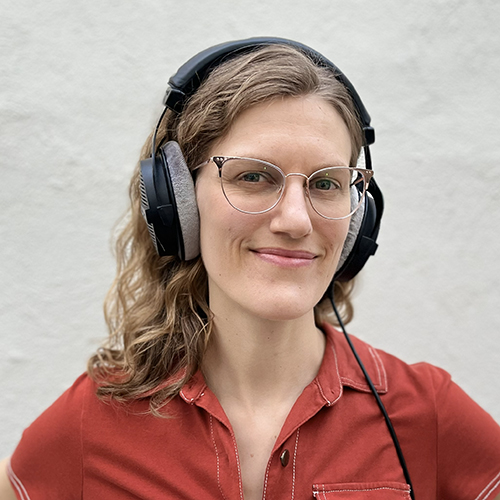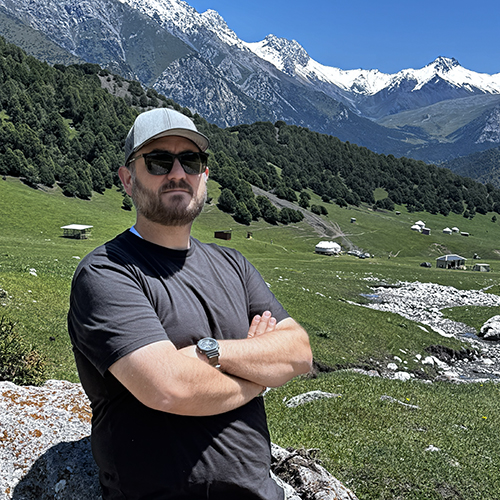A UW student strolls past a trio of shiny bins for trash, recycling, and compost. She pauses, intrigued by colorful images cascading down vertical screens above each bin. As photos of coffee cups and banana peels and condiment containers scroll past, she tosses her own empty cuppa joe into the compost bin.
“You just composted 2.31 ounces,” announces a message on the compost screen. “If everyone on campus composted this amount today, UW would save $1,181.00.”

The interactive recycling and composting station was designed by an interdisciplinary research group led by Karen Cheng and Kristine Matthews, professors of visual communication design in the School of Art + Art History + Design. The station was installed in UW’s PACCAR Hall in 2016 and later relocated to Odegaard Library. It will move to its permanent home by the new Starbucks café in the Husky Union Building (HUB) this summer, thanks to a collaboration with UW Housing and Food Services, UW Recycling, and the HUB.
The goal is to divert garbage from landfills. “The bins give users positive feedback for recycling or composting their waste,” says Cheng. “This was very surprising to users, because the normal trash experience is mindless—people generally don’t think at all when throwing something away.”
The station consists of three bins, each fitted with a weight sensor, microcomputer, and digital screen. Scrolling images remind users which items go into each receptacle. When people toss items into the compost or recycling bins, a sensor weighs the deposit and the screen switches to a message about how much money was saved by that action, as well as the hypothetical savings if everyone on campus did the same.

The interactive station was inspired by a course in the Master of Human Computer Interaction and Design (MHCI+D) program, co-taught by Cheng and MHCI+D director Linda Wagner. After hearing from guest speakers from UW Recycling and the UW Garbology Project, students had three weeks to come up with design solutions for reducing waste on campus. Two ideas seemed feasible—one showed the money saved through recycling and composting, the other used a steady stream of images to explain what goes in each bin. Cheng decided to combine the two ideas, eventually receiving support from the UW’s Royalty Research Fund to realize the project. By the time the funding arrived, the MHCI+D students had graduated and moved on, so Cheng recruited Matthews and a group of design students to help with the project.
That’s one of the fascinating things about interaction design — seeing how people actually use a product, and seeing it change behavior.
The first task was to learn what aspects of recycling and composting trip people up the most. By testing the sorting skills of UW staff and students, the team learned that the biggest challenge is knowing what is compostable. (For the record, almost everything purchased in a UW dining hall or cafe is compostable, including straws and stir sticks. Chip bags and granola bar wrappers are among the rare exceptions.)
The team designed simple yet engaging scrolling displays to remind users what goes in each bin, and developed messages about cost savings, which pop up when items are tossed in the recycle or compost bins. The team considered adding a “ka-ching” with each deposit, but decided the sound might be too repetitive and distracting.
After the interactive station was installed, Cheng and Matthews collaborated with anthropology professor Peter Lape and doctoral candidate Jack Johnson to study its impact. “In the beginning, many people watched the display without using it,” Cheng recalls. “After about a week they started using it, and showing how it worked to others. That’s one of the fascinating things about interaction design—seeing how people actually use a product, and seeing it change behavior.” The team found that correct composting increased by 20 percent and incorrect recycling decreased by 15 percent at the new station. The overall amount of waste correctly diverted from landfill increased by 8 percent—a substantial environmental impact. The project has since been recognized by design and sustainability groups, earning awards from Communication Arts and the Society of Experiential Graphic Design, and being named a Kimberly-Clark Sustainable Campus Competition finalist.
The interactive station will get more of a workout in the HUB, which is visited by thousands of people each day. The team is adding an animated clip of corn morphing into a plastic cup to stress that the UW’s plastic cups are compostable, and they may tweak other aspects of the display to encourage more composting and recycling. Cheng is also working with the UW startup EvoEco to commercialize the design for broader use in the private sector and at other universities.
“It’s very hard to get people to change behavior,” says Cheng. “But we’re hoping that we can make recycling and composting fun and interesting by giving people positive feedback for doing the right thing.”
More Stories

Bringing Music to Life Through Audio Engineering
UW School of Music alum Andrea Roberts, an audio engineer, has worked with recording artists in a wide range of genres — including Beyoncé.

Through Soil Science, an Adventure in Kyrgyzstan
Chemistry PhD alum Jonathan Cox spent most of 2025 in Kyrgyzstan, helping farmers improve their soil—and their crops—through soil testing.

A Healing Heart Returns
In February, the UW Symphony will perform a symphony that Coast Salish elder Vi Hilbert commissioned years ago to heal the world after the heartbreak of 9/11. The symphony was first performed by the Seattle Symphony in 2006.